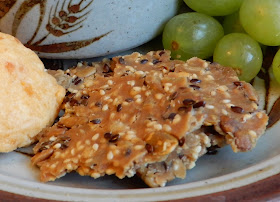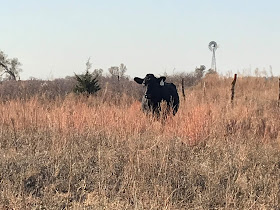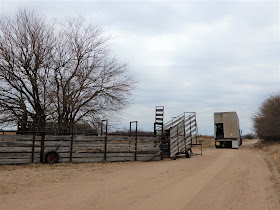I could have gone to the store and purchased crackers. Nobody asked me to make a homemade version - much less two. But when do I ever make things easy on myself? (Answer? Rarely.)
And did I mention I was already in charge of making "fancy" cookies for a South Central Community Foundation grants award reception the very same evening? And, if truth is told, no one told me I had to make "special" cookies for that either. I just think an event like that deserves a festive flair.
 |
| For recipes: Macaroons, Pumpkin No-Bakes, Mexican Wedding Cookies, M & M Bars, Scarecrow Bars |
Thankfully, I could make both the cookies and the crackers ahead of time. So, between helping move cattle, feeding cattle, working cattle, recording my radio reports, blogging, volunteering and assorted other tasks, I made homemade crackers.
My sister, Darci, shared a recipe she and her husband Andrew had enjoyed while they were visiting friends in New Zealand. When I was tasked with cracker duty, I remembered that earlier recipe via email. It required a trip to Glenn's Bulk Foods to get all the different kinds of seeds, but they turned out well. They were chock-full of flax, sesame, pumpkin and sunflower seeds.
I also remembered some cheesy crackers that were served at a local restaurant's Valentine sweethearts' meal several years ago. Since that restaurant is no longer in business, I wasn't able to track down her specific recipe. But Trisha Yearwood and the Food Network to the rescue. What's not to like about butter and cheese? The cheesy crackers are had plenty of both, along with flour and seasonings.
The PEO ladies didn't eat enough of the crackers.
Randy and I enjoyed some with homemade tomato and rice soup last week. I stashed most in the freezer and then used them as an accompaniment to two different kinds of soup at a Bible study Tuesday evening.
In the photo above, the crackers are pictured with a tomato rice soup that can be found at this link on my blog. On Tuesday night, I served the crackers with a Slow Cooker Potato Soup and a Slow Cooker Chicken and Rice Soup.
My church group also got the leftover cookies.
Sue's Crackers
From Wellington, New Zealand via my sister, Darci
1/2 cup sunflower seeds1/4 cup flax seeds
1/4 cup sesame seeds
1/4 cup pumpkin seeds
1 tsp. salt
1 1/2 cup spelt flour or rice flour (I used rice flour)
1/2 cup water
1/3 cup olive oil
Sea salt for sprinkling (opt.)
Preheat oven to 350 degrees. Mix seeds, salt and flour. Add water and olive oil; mix.
Spread thin on a 16 X 12 inch baking sheet with lip. Sue's instructions say to divide into two pieces and roll between two sheets of parchment paper until 3 mm thick (that's 1/25th inch - so it's very thin. I probably didn't get it quite that thin.) I then just put the bottom parchment paper with the dough on the baking sheet.
Lightly sprinkle with sea salt, if desired.
Bake 20 to 25 minutes or until golden and crisp. Place on rack to cool. Break into pieces.
You can serve as crackers. The "crumbles" are delicious as a crunch element in a creamy tomato or potato soup.

Cheese Crackers
Modified from the Food Network
1 cup butter, softened3 10-oz. bricks sharp Cheddar cheese, shredded cold, then left at room temperature
4 cups flour
2 tsp. salt
1/8 tsp. black pepper
1/8 tsp. cayenne pepper
Dash of garlic powder
Cooking spray
Note: Don't use already shredded cheese because it's treated with an anti-caking agent. Shred your own for this recipe.
Preheat oven to 325 degrees. Put the softened cheese and butter into the bowl of a heavy-duty stand mixer. Using the heaviest mixer paddle, beat until the mixture has the consistency of creamed butter.
In a large bowl, combine 3 cups of the flour with the salt, black pepper, cayenne pepper and garlic powder. Gradually add the seasoned flour mixture to the cheese mixture, beating well after each addition. Add the remaining 1 cup of unseasoned flour a little at a time until the dough is somewhat stiff but still soft enough to be manipulated. You will likely not need to add all 4 cups of flour.
Use a 1-inch cookie scoop and scoop onto baking sheets that have been sprayed with cookie spray. (Or use parchment covered baking sheets.) Press down using a glass or you may use a fork. Bake until golden brown and crisp, 15 to 20 minutes, depending on your oven.
The original recipe made these into cheese straws. I don't have a metal cookie press, and I couldn't get the dough to push through the press I had, so I made them as explained above. However, if you have a better cookie press, here's the instructions for making them into cheese straws:
Lightly spray 4 cookie sheets with cooking spray. Put a portion of the dough into a cookie press fitted with the star tip and press the dough onto a cookie sheet into long strips that run the length of the pan. Repeat until the pan is full. Bake until straws are golden brown and crisp, about 20 minutes.
With your hands or a sharp knife, break or cut the long strips into 3-inch lengths. Use a flat, thin spatula or an egg turner to remove the cheese strips from the pan. Allow them to cool on a wire rack. When they are completely cool, serve or store in a tightly-covered container.
This makes a lot! The original recipe said 4 dozen cheese straws.































































